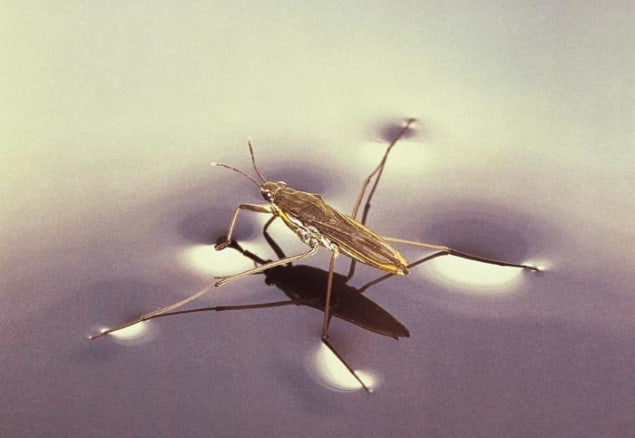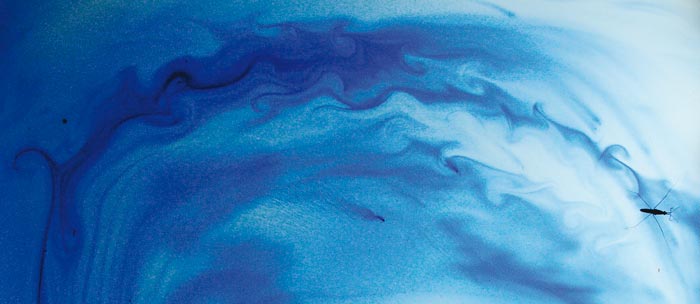Why can pond skaters skip so effortlessly across water? Stephen Ornes explains how these creatures’ secrets were revealed using dyed water and a high-speed video camera

Gods in Ancient Egypt could do it; so allegedly could Buddha and Jesus. But for the rest of us lowly human beings – at least, those of us without divine parentage or supernatural abilities – the closest we can get to walking on water is to strap on a pair of pontoon shoes and hope for the best (an idea first envisaged in sketches by Leonardo da Vinci). But in the animal kingdom, the ability is nothing new. The basilisk lizard uses its specially shaped feet to slap the surface hard enough to keep from sinking as it runs across water. Dolphins use the same technique with their tails, as do some birds.
Most insects take a different approach. The vast majority of the million or so identified species of insects live either in the air or on land, but a tiny fraction – about 0.1% – live on water, at least part of the time. One of those water dwellers, the pond skater (also known as the water strider), is particularly adept at staying afloat. It can sit still atop the water, or scurry across at speeds of 150 cm/s – about three miles per hour.
The reason why pond skaters can stay afloat is that the surface tension of water acts like a skin. Water molecules have cohesive forces between them, and the pond skater’s weight is too small to overcome those forces. That is fine for standing still, but if the insect wants to move, Newton’s third law of motion dictates that it has to push on something – and the only thing available is the water.
Our latest knowledge of these little animals is largely thanks to the efforts of David Hu, who as a mathematics graduate student at the Massachusetts Institute of Technology (MIT) spent four years studying them, analysing their sizes and shapes and trying to understand the physics that keeps these bugs afloat. He worked on the project with his PhD supervisor, John Bush, who focuses on tackling real-world fluid-dynamics problems.
“They have to row without breaking the surface of the water,” says Hu, now running his own biology-meets-mechanical-engineering lab at the Georgia Institute of Technology in Atlanta. “If they move too quickly, they will break the surface. That’s a non-intuitive idea for people to grasp, but you can see it if you push on the surface of water gently with a paperclip. You see these ripples of waves shoot out, and the pond skaters basically have to row on them very gently.”
Hidden vortices
Before Hu’s work, experiments and observations had suggested that pond skaters propel themselves forwards by making tiny ripples in the water with their legs. This idea was intuitively appealing because these “capillary waves” are readily visible in the wake of a pond skater skipping across a wet surface. But it led to a problem called “Denny’s paradox”, first articulated by biologist Mark Denny in 1993. He pointed out that infant pond skaters cannot move their legs faster than the phase speed of the capillary waves – a feat necessary to create them.
Hu and Bush decided to investigate using pond skaters gathered from local ponds. These creatures reproduced in the laboratory and so gave the researchers plenty of infants with which to investigate Denny’s paradox. And to see what was really happening in the water, Hu and Bush filmed the insects using a high-speed camera.
They found that pond skaters use the middle of their three pairs of legs like a rower uses oars in a rowboat. When an oar slices the water, it creates swirling vortices just beneath the surface that twist away from the boat, imparting forward momentum to the boat. Similarly, the pond skater’s legs leave behind the same vortices under the water’s surface. In Bush’s lab at MIT, the vortices became visible when the scientists sent the pond skaters scampering across water filled with colourful floating particles.

Bush and Hu noted that the action also created capillary waves – those tiny ripples observed by Denny and other biologists – but calculated that those waves’ contributions to the bug’s forward motion were much smaller than they had anticipated, and not strong enough to move the bug.
Coveted coating
What is also interesting about pond skaters is that specialized hairs coated in a wax-like substance cover their legs, and bubbles on these hairs keep the water out. There are, according to Hu, thousands of hairs per square millimetre and the waxy substance on the hairs is coveted by human designers and materials scientists because synthetic materials usually rely on waterproofing chemicals that wash away. “No-one knows how to make a permanent water-repellent material,” he says.
It is these hairs that make the pond skater’s rowing action possible. Only the very tips of the hairs penetrate the surface of the water, creating those vortices and, in turn, transferring momentum past the air-water barrier. The particular arrangement of those hairs resembles those on a butterfly’s wings that shuttle water droplets towards the wingtips. On pond skaters, those hairs point in a particular direction, giving the insect a preferred direction and ensuring that the pond skater does not veer off course – whether alive or dead.
“If you have a dead water strider and blow on it, it will still go forward,” Hu says.
Hu has gone on to look at how other insects, including land dwellers, survive around water. In 2011 he and a team from his lab described how colonies of Brazilian fire ants, normally abysmal swimmers, weave themselves together to build a waterproof raft. On its own, a single ant is not very water repellent, but when they link together arm in arm they can create “waterproof surfaces similar to how we create Gore-Tex”, Hu says. The principal idea is the same: create a fabric that is highly textured and uses tiny pockets of air to keep water out. But the ants, like the pond skaters – and the gods – are much better at it than human inventors.
“We understand all these great things in nature,” Hu says, “but we still can’t build an equivalent in our everyday lives.”



